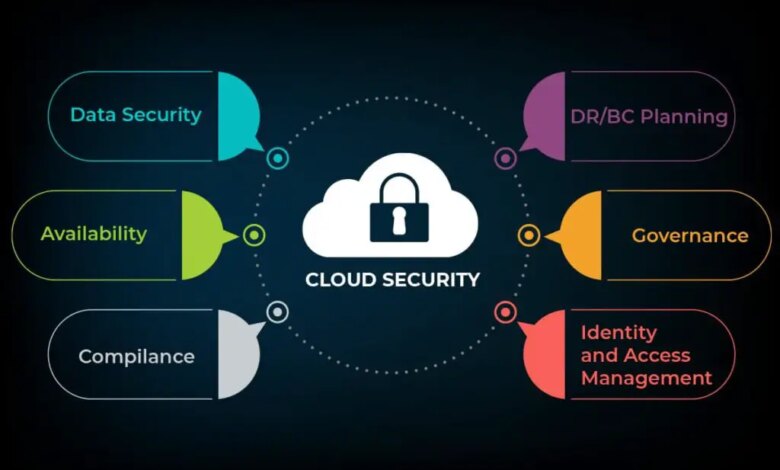
Cloud Security: Scaling Protection for Large Campuses
How cloud based technology can scale security for large and multi site campuses – How cloud-based technology can scale security for large and multi-site campuses is a question that’s increasingly on the minds of IT leaders. As institutions grow and campuses expand, the traditional approach to security simply can’t keep up. The sheer volume of devices, users, and data makes it challenging to manage security effectively, leaving campuses vulnerable to attacks.
This is where the cloud comes in, offering a scalable, flexible, and cost-effective solution to address these modern security challenges.
Cloud-based security solutions provide a centralized platform for managing security policies, monitoring activity, and responding to threats across multiple campuses. This approach simplifies operations, improves visibility, and enhances the overall security posture of the institution. From cloud access security brokers (CASBs) to security information and event management (SIEM) systems, there’s a range of cloud-based tools designed to address specific security needs and ensure the safety of sensitive data and systems.
The Growing Need for Scalable Security
Securing large, multi-site campuses presents a significant challenge for organizations. Traditional security approaches, often reliant on physical infrastructure and on-premises solutions, struggle to keep pace with the evolving needs of modern campuses. The complexities of managing diverse locations, dispersed resources, and ever-increasing threat landscapes demand a more dynamic and adaptable security posture.
Cloud-based technology emerges as a powerful solution, offering scalability, flexibility, and cost-effectiveness to address these challenges.
The Challenges of Securing Large Campuses
Securing large, multi-site campuses presents numerous challenges, including:
- Managing Diverse Locations:Campuses often encompass multiple buildings, geographically dispersed locations, and diverse environments, requiring a comprehensive security strategy that addresses the unique vulnerabilities of each site.
- Protecting Dispersed Resources:Critical assets, such as data centers, research labs, and sensitive information, are spread across the campus, demanding robust security measures to safeguard against potential threats.
- Evolving Threat Landscape:The constant evolution of cyber threats, including malware, phishing attacks, and data breaches, requires a proactive and adaptable security approach to mitigate risks.
- Limited Visibility and Control:Traditional security systems often lack the centralized visibility and control needed to effectively manage security across multiple locations, making it difficult to identify and respond to incidents in a timely manner.
- High Costs and Complexities:Maintaining and upgrading on-premises security infrastructure can be expensive and time-consuming, especially for large campuses with diverse security needs.
Limitations of Traditional Security Approaches
Traditional security approaches, often based on on-premises solutions, face limitations in addressing the challenges of securing large campuses:
- Limited Scalability:On-premises security solutions are often designed for specific locations and may struggle to scale effectively as the campus grows or expands to new locations.
- Lack of Flexibility:Traditional security systems can be rigid and inflexible, making it difficult to adapt to changing security needs and emerging threats.
- High Maintenance Costs:On-premises solutions require significant ongoing maintenance, including hardware upgrades, software updates, and technical support, adding to operational costs.
- Limited Visibility and Control:On-premises security systems often lack centralized visibility and control, making it difficult to monitor and manage security across multiple locations.
- Security Gaps:Traditional approaches may have security gaps, such as isolated security systems that lack communication and coordination, leaving the campus vulnerable to attacks.
The Benefits of Cloud-Based Security for Large Campuses
Cloud-based security solutions offer a compelling alternative to traditional approaches, providing numerous benefits:
- Scalability:Cloud-based security solutions can easily scale to accommodate the needs of large campuses, allowing organizations to add or remove resources as needed.
- Flexibility:Cloud-based solutions offer a high degree of flexibility, allowing organizations to customize their security posture to meet specific needs and adapt to changing threats.
- Cost-Effectiveness:Cloud-based security solutions can be more cost-effective than traditional approaches, eliminating the need for expensive hardware and software investments.
- Centralized Visibility and Control:Cloud-based solutions provide centralized visibility and control over security across multiple locations, enabling organizations to monitor and manage security effectively.
- Enhanced Security Posture:Cloud-based security solutions offer a comprehensive range of security features, including threat detection, intrusion prevention, and data loss prevention, strengthening the campus’s overall security posture.
Cloud-Based Security Solutions for Campuses: How Cloud Based Technology Can Scale Security For Large And Multi Site Campuses
Cloud-based security solutions offer a robust and scalable approach to safeguarding multi-site campuses. They provide centralized management, real-time visibility, and advanced security capabilities, ensuring comprehensive protection across geographically dispersed locations. These solutions address the unique challenges of large campuses, such as managing diverse user populations, securing sensitive data, and responding to evolving threats.
Cloud Access Security Broker (CASB)
A CASB acts as a security gatekeeper between users and cloud applications, enforcing security policies and controlling access to cloud resources.
- Features:CASBs offer various features, including data loss prevention (DLP), threat detection and response, user activity monitoring, and compliance enforcement.
- Benefits:CASBs provide comprehensive visibility into cloud app usage, enforce consistent security policies across different cloud services, and mitigate risks associated with unauthorized access and data breaches.
- Campus Security Contribution:CASBs help secure sensitive data stored in cloud applications, prevent unauthorized access to cloud resources, and ensure compliance with industry regulations. They also enable centralized management of cloud security policies, simplifying the task of managing security across multiple campuses.
Security Information and Event Management (SIEM)
SIEM solutions collect, analyze, and correlate security data from various sources, including network devices, firewalls, and endpoints. This data is used to detect and respond to security incidents.
- Features:SIEMs provide real-time threat detection, security incident response, log management, and reporting capabilities.
- Benefits:SIEMs offer comprehensive visibility into security events across the campus, automate incident response, and improve security posture by identifying and mitigating threats quickly.
- Campus Security Contribution:SIEMs provide a centralized platform for monitoring and responding to security threats, enabling faster incident detection and resolution. They also facilitate compliance audits by providing detailed security event logs and reports.
Cloud-native Endpoint Detection and Response (EDR)
Cloud-native EDR solutions protect endpoints from threats by providing real-time threat detection, investigation, and response capabilities. They are specifically designed for cloud environments and offer enhanced security features.
- Features:Cloud-native EDRs offer advanced threat detection, automated response, and comprehensive endpoint visibility, enabling proactive threat mitigation.
- Benefits:Cloud-native EDRs provide comprehensive endpoint protection, reduce the time to detect and respond to threats, and minimize the impact of security incidents.
- Campus Security Contribution:Cloud-native EDRs secure endpoints across multiple campuses, providing a centralized platform for managing and responding to threats. They also enhance incident response capabilities by offering real-time threat detection and automated remediation.
Cloud-based Firewalls
Cloud-based firewalls offer a scalable and flexible solution for securing network traffic and protecting campuses from external threats. They are deployed in the cloud and provide centralized management and monitoring.
Cloud-based technology is a game-changer for campus security, offering scalability and centralized management across multiple locations. But before you dive into implementing these solutions, it’s crucial to understand your financial standing. Take this quick quiz to see where you stand financially: where do you stand financially get a score on this quiz and our advice.
Once you have a clear picture of your financial situation, you can make informed decisions about how to best leverage cloud-based security solutions for your large and multi-site campus.
- Features:Cloud-based firewalls provide network segmentation, intrusion prevention, and application control capabilities, ensuring secure network access and data protection.
- Benefits:Cloud-based firewalls offer scalability, flexibility, and cost-effectiveness compared to traditional on-premises firewalls. They also provide centralized management and monitoring, simplifying security administration.
- Campus Security Contribution:Cloud-based firewalls protect campuses from external threats by filtering network traffic, preventing unauthorized access, and enforcing security policies. They also enable centralized management and monitoring of security policies, simplifying security administration across multiple campuses.
Multi-factor Authentication (MFA)
MFA adds an extra layer of security by requiring users to provide multiple forms of authentication, such as a password and a one-time code, before granting access to sensitive data or systems.
- Features:MFA methods include one-time passwords (OTPs), biometrics, and push notifications, providing robust authentication mechanisms.
- Benefits:MFA significantly strengthens security by making it harder for unauthorized individuals to gain access to systems and data. It reduces the risk of unauthorized access and data breaches.
- Campus Security Contribution:MFA protects sensitive data and systems by requiring strong authentication, reducing the risk of unauthorized access. It also enhances user security by preventing unauthorized access to accounts, even if passwords are compromised.
Scaling Security Across Multiple Sites

Managing security across multiple campuses can be a complex and challenging task. With the growing number of connected devices and the increasing sophistication of cyber threats, organizations need a scalable and efficient security solution to protect their assets. Cloud-based security solutions offer a centralized platform for managing and controlling security policies across multiple locations, providing a comprehensive and adaptable approach to campus security.
Centralized Management and Control
Cloud-based security solutions enable centralized management and control of security policies across multiple campuses. This means that IT teams can configure and enforce security policies from a single console, regardless of the location of the campus.
Imagine a sprawling campus with multiple buildings and thousands of users. Keeping it secure can be a daunting task. Cloud-based technology offers a solution by centralizing security management and providing scalability for these large, multi-site environments. This is especially relevant in the current climate, with news like the pentagon planning for possible pelosi trip to taiwan ap highlighting the importance of robust security measures.
Cloud-based solutions can adapt to changing threats and ensure that critical data and infrastructure remain protected, no matter the scale or complexity of the campus.
- Consistent Security Policies:Cloud platforms ensure that all campuses adhere to the same security policies, minimizing inconsistencies and vulnerabilities across the network.
- Simplified Policy Deployment:Updates and changes to security policies can be deployed quickly and efficiently to all campuses simultaneously, eliminating the need for manual configuration at each site.
- Reduced Complexity:Centralized management simplifies security operations, reducing the need for multiple security consoles and tools, and minimizing the risk of human error.
Streamlined Security Operations
Cloud-based security solutions can significantly streamline security operations, reducing the burden on IT teams.
- Automated Threat Detection and Response:Cloud platforms use advanced analytics and machine learning to detect and respond to threats in real-time, freeing up IT teams to focus on more strategic tasks.
- Simplified Security Reporting:Cloud solutions provide comprehensive security reports, offering insights into security posture, threat trends, and compliance status, allowing for proactive risk management.
- Scalability and Flexibility:Cloud-based security solutions can scale up or down as needed, adapting to changes in campus size, network complexity, and security requirements.
Real-Time Visibility and Monitoring
Cloud-based solutions provide real-time visibility and monitoring across all campus locations.
- Unified Security Dashboard:A centralized dashboard provides a comprehensive view of security events, alerts, and logs across all campuses, allowing IT teams to identify and address potential threats quickly.
- Network Performance Monitoring:Cloud platforms monitor network performance and identify potential bottlenecks or vulnerabilities, ensuring optimal network availability and security.
- Data Analytics and Reporting:Advanced analytics tools provide insights into security trends, user behavior, and threat patterns, enabling organizations to make data-driven decisions to improve security posture.
Enhancing Security Posture Through Cloud Technology
Cloud-based security solutions offer a comprehensive approach to fortifying campus security, encompassing perimeter protection, data security, and threat detection and response. By leveraging the power of the cloud, campuses can significantly enhance their security posture, ensuring the safety and integrity of their critical assets.
Strengthening Perimeter Security, How cloud based technology can scale security for large and multi site campuses
Cloud-based security solutions can bolster perimeter security by providing a robust and adaptable defense against external threats.
- Next-generation firewalls (NGFWs)deployed in the cloud can effectively filter malicious traffic and prevent unauthorized access to the campus network. These firewalls are constantly updated with the latest threat intelligence, ensuring they remain effective against emerging threats.
- Intrusion detection and prevention systems (IDPSs)in the cloud monitor network traffic for suspicious activity and can automatically block or quarantine malicious connections. This proactive approach helps prevent attacks before they can cause significant damage.
- Virtual private networks (VPNs)provide secure connections for remote users, ensuring that sensitive data remains protected even when accessed from outside the campus network. Cloud-based VPNs offer scalability and flexibility, accommodating the growing number of remote workers and students.
Protecting Data in Transit and at Rest
Protecting data in transit and at rest is crucial for maintaining data integrity and compliance.
- Data encryptionis essential for safeguarding data both during transmission and when stored on servers. Cloud-based solutions can encrypt data at rest using advanced algorithms and encrypt data in transit using protocols like Transport Layer Security (TLS) or Secure Sockets Layer (SSL).
This ensures that even if data is intercepted, it remains inaccessible to unauthorized parties.
- Data loss prevention (DLP)solutions in the cloud can monitor data movement and identify sensitive information that might be leaving the campus network without authorization. This helps prevent data breaches and ensures that critical information remains within the organization’s control.
Detecting and Responding to Threats
Proactive threat detection and response are critical for minimizing the impact of security incidents.
- Security information and event management (SIEM)solutions in the cloud aggregate security logs from various sources, providing a centralized view of security events across the campus network. This comprehensive visibility allows security teams to quickly identify and investigate suspicious activities, enabling rapid response to potential threats.
- Endpoint detection and response (EDR)solutions in the cloud monitor individual devices on the campus network for malicious activity. They can detect and respond to threats at the endpoint level, preventing malware from spreading and causing widespread damage.
- Security orchestration, automation, and response (SOAR)platforms in the cloud automate repetitive security tasks, allowing security teams to focus on more strategic initiatives. SOAR platforms can streamline incident response, automate threat hunting, and improve overall security efficiency.
Cloud-Based Threat Intelligence and Analytics
Cloud-based threat intelligence and analytics play a vital role in improving security posture.
- Threat intelligence feedsprovide real-time information on emerging threats, enabling campuses to proactively defend against known vulnerabilities and attack vectors. These feeds are constantly updated with the latest threat data, ensuring that campuses remain informed about the latest threats and can adapt their security strategies accordingly.
- Security analyticsleverage data from various sources, including security logs, threat intelligence feeds, and network traffic, to identify patterns and anomalies that might indicate malicious activity. This advanced analysis helps security teams prioritize threats and allocate resources effectively, focusing on the most critical security risks.
Cloud-based technology is a game-changer for campus security, especially for large and multi-site institutions. It allows for centralized management, real-time monitoring, and seamless scalability, making it easier to adapt to changing needs. The key to success lies in understanding the evolution of brands, just like the article death to lifestyle brands long live lifestyle brands lessons to take and departures to make in contemplating iconic brands like victorias secret and ralph lauren points out.
Similarly, campus security systems need to evolve with the times, adapting to new threats and leveraging technology to stay ahead of the curve.
Compliance and Security Standards
Cloud-based security solutions can help campuses comply with industry regulations and security standards.
- Data privacy regulations, such as the General Data Protection Regulation (GDPR) and the California Consumer Privacy Act (CCPA), require organizations to protect sensitive personal information. Cloud-based security solutions can help campuses implement robust data protection measures, ensuring compliance with these regulations.
- Industry-specific security standards, such as the Payment Card Industry Data Security Standard (PCI DSS) for organizations handling credit card information, require specific security controls. Cloud-based solutions can provide the necessary tools and features to meet these standards, ensuring that campuses are compliant with industry requirements.
Case Studies and Best Practices
Real-world examples and best practices showcase the successful implementation of cloud-based security solutions on campuses. Understanding these implementations provides valuable insights into designing and deploying secure cloud-based infrastructure for educational institutions.
Case Studies of Successful Implementations
Several institutions have successfully implemented cloud-based security solutions, improving their security posture and enhancing their overall security effectiveness.
- University of California, Berkeley:The university leveraged a cloud-based security information and event management (SIEM) solution to consolidate security data from various sources, providing a comprehensive view of their security posture. This enabled them to identify and respond to threats more effectively, improving their overall security effectiveness.
- Massachusetts Institute of Technology (MIT):MIT implemented a cloud-based endpoint detection and response (EDR) solution to protect their endpoints from advanced threats. The solution’s ability to detect and respond to threats in real-time significantly enhanced their security posture and reduced the risk of data breaches.
- Stanford University:Stanford University implemented a cloud-based identity and access management (IAM) solution to manage user access to sensitive data and applications. The solution’s ability to enforce strong authentication policies and control access rights ensured the security of their sensitive data and applications.
Best Practices for Designing and Implementing a Secure Cloud-Based Infrastructure
Implementing a secure cloud-based infrastructure requires a strategic approach that incorporates best practices to mitigate risks and enhance security.
- Conduct a thorough risk assessment:Identifying potential threats and vulnerabilities is crucial for designing a secure cloud-based infrastructure. This involves analyzing the campus’s security needs, potential threats, and vulnerabilities, and then implementing appropriate security controls to mitigate those risks.
- Choose a reputable cloud provider:Selecting a cloud provider with strong security credentials and compliance certifications is essential. Ensure the provider has robust security controls, data encryption, and data privacy policies in place to protect your data and applications.
- Implement a layered security approach:Employing multiple layers of security controls provides a more comprehensive and robust security posture. This includes using firewalls, intrusion detection systems, antivirus software, and other security tools to protect your network and data.
- Regularly monitor and update security controls:Continuously monitor your security posture and update security controls as needed. This includes regularly scanning for vulnerabilities, patching security holes, and updating security software to stay ahead of emerging threats.
Comparison of Cloud-Based Security Solutions
Various cloud-based security solutions offer different features and capabilities. Evaluating these solutions based on their strengths, weaknesses, and key features can help you choose the best solution for your campus.
| Solution | Strengths | Weaknesses | Key Features |
|---|---|---|---|
| Cloud-Based SIEM | Provides a centralized view of security data, enabling efficient threat detection and response. | May require significant data processing and analysis capabilities. | Log management, threat intelligence, incident response, security analytics. |
| Cloud-Based EDR | Offers real-time threat detection and response capabilities, protecting endpoints from advanced threats. | May require specialized expertise for deployment and management. | Endpoint protection, threat detection, incident response, malware analysis. |
| Cloud-Based IAM | Simplifies user access management, enforcing strong authentication policies and controlling access rights. | May require integration with existing systems and processes. | User authentication, authorization, access control, single sign-on. |
Future Trends in Cloud-Based Campus Security

The realm of campus security is constantly evolving, driven by the rapid advancements in technology. Cloud-based security solutions are at the forefront of this evolution, offering unprecedented scalability, flexibility, and adaptability. As we look towards the future, several emerging trends are poised to further revolutionize how campuses secure their assets and personnel.
Artificial Intelligence and Machine Learning for Threat Detection and Response
AI and ML are transforming security by enabling more proactive and intelligent threat detection and response. These technologies can analyze vast amounts of data from various sources, including network traffic, user behavior, and security logs, to identify patterns and anomalies that might indicate malicious activity.
AI-powered security systems can:
- Identify and prioritize threats:AI algorithms can analyze security data to identify potential threats, prioritize them based on their severity, and alert security personnel accordingly.
- Automate incident response:AI can automate tasks such as isolating infected devices, blocking malicious IP addresses, and triggering security protocols. This helps reduce the time it takes to respond to threats and minimize potential damage.
- Improve threat intelligence:By analyzing data from various sources, AI can help security teams stay ahead of emerging threats and vulnerabilities. This enables them to develop more effective security strategies and deploy appropriate countermeasures.
Zero Trust Security Frameworks
The traditional security model, based on perimeter security, is becoming increasingly ineffective in the face of evolving threats. Zero Trust security frameworks address this challenge by assuming that no user or device can be trusted by default, regardless of their location.
This approach emphasizes continuous verification and authentication, granular access control, and robust data protection measures.
- Micro-segmentation:Zero Trust frameworks break down the network into smaller segments, limiting access to specific resources based on user identity and device status. This approach reduces the impact of security breaches by limiting the spread of malware and unauthorized access.
- Multi-factor authentication:Implementing multi-factor authentication (MFA) ensures that users are who they claim to be before granting them access to sensitive data and systems. MFA adds an extra layer of security by requiring users to provide multiple forms of identification, such as a password and a one-time code.
- Data encryption:Encrypting data at rest and in transit protects it from unauthorized access, even if a security breach occurs. Zero Trust frameworks emphasize strong encryption protocols to safeguard sensitive information.
Cloud-Based Security Orchestration and Automation
As security solutions become increasingly complex, managing them effectively can be a daunting task. Cloud-based security orchestration and automation (SOAR) platforms provide a centralized platform for managing and automating security processes, enabling security teams to respond to threats more efficiently and effectively.
- Streamlined incident response:SOAR platforms automate routine tasks, such as collecting evidence, creating incident reports, and triggering security protocols. This frees up security teams to focus on more strategic tasks, such as threat analysis and remediation.
- Improved visibility and control:SOAR platforms provide a single pane of glass for managing security operations, offering a comprehensive view of security events, alerts, and responses. This enhanced visibility helps security teams identify patterns, prioritize threats, and make informed decisions.
- Faster remediation:By automating tasks and streamlining processes, SOAR platforms reduce the time it takes to respond to threats and remediate security incidents. This is crucial for minimizing potential damage and maintaining business continuity.
Last Point
The adoption of cloud-based security solutions is not just a trend; it’s a necessity for institutions seeking to protect their campuses in today’s evolving threat landscape. By leveraging the power of the cloud, institutions can achieve a higher level of security, streamline operations, and build a more resilient security infrastructure that adapts to the ever-changing needs of a modern, multi-site campus.






